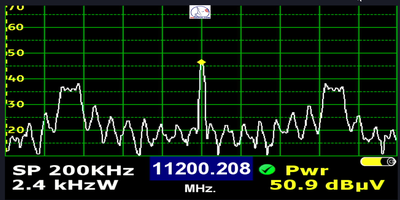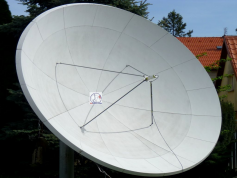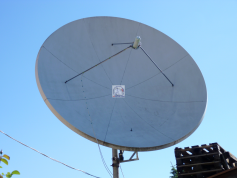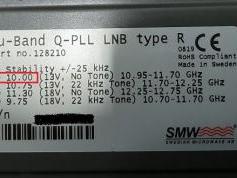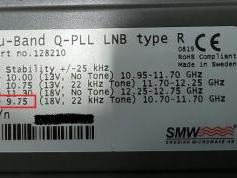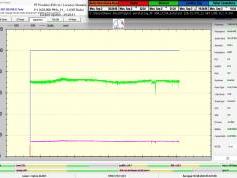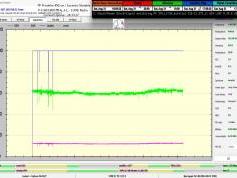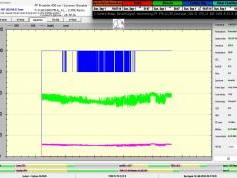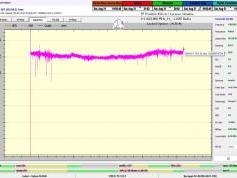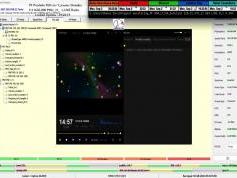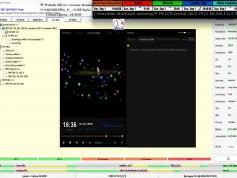Low Symbol Rates (SR) in the practice of satellite reception
Niedrige Symbolraten (SR) in der Praxis des Satellitenempfangs
Nízke Symbolové rýchlosti (SR) v praxi satelitného príjmu

Low Symbol Rates (SR) in practice of satellite reception
Eutelsat 21B at 21.5°E-Western : PF Prodelin 450 & PF Prodelin 370
11 603,800 MHz_H_SR=185 ksym/s : LUXE Radio
( Update date: 11.9.2024 )
>Eutelsat 21B at 21.5°E_Low Symbol Rate>SR=185 ksym/s in satellite reception practice & Atlantic Radio <
period of t=136 hours, with a quality peak SNR=15.5 dB on the carrier C/f=11,603.790 MHz - LUXE Radio, with an SR value of 185 ksym/s.
Überwachungseinheit von t=136 Stunden nachweisen, bei einem Qualitätsspitzenwert von SNR=15,5 dB auf dem Träger C/f=11.603,790 MHz - LUXE Radio,
mit einem SR-Wert von 185 ksym/s.
monitoringu t=136 hodín,pri špičke kvality SNR=15,5 dB na nosnej C/f=11 603,790 MHz-LUXE Rádio s hodnotou SR=185 ksym/s
►►Eutelsat 21B at 21.5°E-Western : Low symbol rates (SR) in satellite reception practice
Installed symmetric reflectors and the diameter of their effective area : D=370 & 450 cm
R1 R2
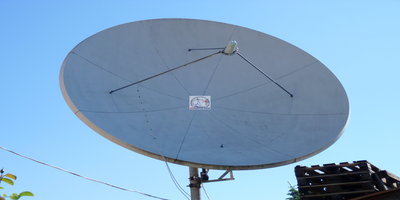
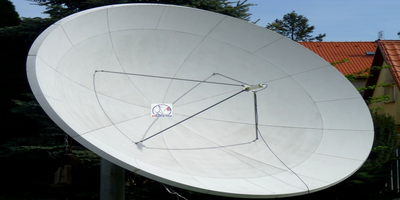
►Signálny reťazec je tvorený / The signal chain consists of the following components : Prodelin 450/370 cm
that minimize any wave reflections,maximize its signal permeability,with high conductivity of the tube, and a specific focus on implementing the waveguide
flange > SMW PLL LNB 9.75 GHz +/- 10 kHz
PF Prodelin 370 cm > Primary feedhorn placed in the manual SKEW rotation mechanism > OMT type ESA-1212-X/1 > LNB SMW Q-PLL type R, LOF stability +/- 25 kHz
Drehbank), mit physikalischen Modifikationen, die jegliche Wellenreflexionen minimieren, die Signalpermeabilität maximieren, mit hoher Leitfähigkeit des Rohrs
und einem speziellen Fokus auf die Implementierung der Wellenleiterflansche > SMW PLL LNB 9.75 GHz _ +/- 10 kHz
►►Eutelsat 21B at 21.5°E-Western : Beacon frequency / TT&C
Eutelsat 21B : BEACON FREQUENCY > f=12 500.5 MHz_V
- šírka rozmietania SP=100 kHz -
- hodnota vstupných filtrov RBW= 1 W/kHz + 600 W/Hz -
► týmto som dokázal že mnou navrhnutý signálny reťazec generuje frekvenčné údaje s vysokou presnosťou (na jednotky tisícin-1/1000 z jednotky 1 MHz)
čiže publikované údaje sú hodnoverné a relevantné pre vedecko-výskumnú prácu v oblasti vlnovej fyziky
►I have demonstrated through this that the signal chain I have designed generates frequency data with high precision
(to the order of one-thousandth, 1/1000, of 1 MHz). Therefore, the published data is reliable and relevant.
Eutelsat 21B : TT&C > 11 699,80 MHz_H / 11 200,20 MHz_H
►►Eutelsat 21B at 21.5°E-Western-spectrum analysis : 11 603,800 MHz_H - LUXE Radio
C1_11 599,250 MHz : Chada FM
C2_11 599,530 MHz : Medina FM
C3_11 599,760 MHz : MED Radio
C5_Carrier width/Trägerbreite : 249 kHz
SPAN=1 MHz : 11 599,250>11 599,530>11 599,760 MHz >11 602,760 > 11603,790 MHz
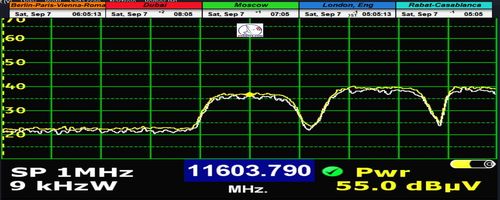
►►Eutelsat 21B-LUXE Radio : Selection of the oscillator in relation to the resulting quality and continuity of the Lock process
eines symmetrischen Prodelin-Reflektors mit einem Durchmesser von d=370 cm.
►A_Vychádzajúc,alebo na základe aplikovaného štandardu DVB-S/QPSK na signálnej trase s aplikovanou hodnotou Symbolovej rýchlosti SR=185 ksym/s,
dosiahnuté priebehy kvality (SNR+Q) a kanálovej chybovosti ChBER týmto verifikujú dosiahnutie stability príjmu na 100%,kedy ani na jednu sekundu počas
výkonu jednotky signálneho monitoringu t=24 hodín nedošlo k rastu kanálovej chybovosti pred Viterbi korekciou do rádu * 1E-4 (or 1*10-4),alebo k okamžitému
poklesu modrého priebehu kvality "Q" na úroveň Q=80%.Inak povedané počas celého dokazovania sa kanálová chybovosť,alebo Pre-Viterbi BER,pohybovala
v rozsahu od 1*10-5 do 1*10-9,čo znamená len jeden chybný Bit od 10 000 až do miliardy z celkovo prijatých pri dosiahnutej špičke kvality v jednotke odstup
Signál/Šum SNR=15 dB
and channel error rate (ChBER) verifies the attainment of 100% reception stability. Throughout the 24-hour operation of the signal monitoring unit, there was not
a single second where the channel error rate before Viterbi correction exceeded the order of 1E-4 (or 1*10-4) or where the blue quality indicator "Q" immediately
dropped to a level of Q=80%. In other words, throughout the entire verification process, the channel error rate, or Pre-Viterbi BER, ranged from 1E-5 to 1E-9,
which means only one erroneous bit out of ten thousand to one billion of the total received at the peak quality, where the Signal-to-Noise Ratio (SNR) was 15 dB.
Werte der Qualität (SNR + Q) und der Kanalfehlerrate (ChBER) die Erreichung einer Empfangsstabilität von 100%. Während des 24-stündigen Betriebs
der Signalüberwachungseinheit gab es keine einzige Sekunde, in der die Kanalfehlerrate vor der Viterbi-Korrektur den Bereich von 1E-4 (1*10-4) überschritt oder bei
der der blaue Qualitätswert "Q" sofort auf ein Niveau von Q=80% sank. Anders ausgedrückt, während des gesamten Nachweises bewegte sich die Kanalfehlerrate oder
Pre-Viterbi BER im Bereich von 1E-5 bis 1E-9, was bedeutet, dass bei der erreichten Spitzenqualität mit einem Signal-Rausch-Verhältnis (SNR) von 15 dB nur ein
fehlerhaftes Bit von zehntausend bis zu einer Milliarde der insgesamt empfangenen Bits auftrat.
►B_Z hľadiska stability príjmu na výstupe z PF370+LOF 10 GHz sa jedná o plne porovnatelný pribeh ako v odseku /A/,pretože ani na jednu sekundu nedošlo
k výpadku v kontinuite LOCKU nosnej s hodnotou SR=185 ksym/s a štyri krátkodobé poklesy modrého priebehu kvality "Q" na hladiny 60-80%,
alebo do matematických rádov kanálovej chybovosti predkorekcie Viterbi okolo hodnoty 1*10-4,zďaleka nedosahovali hraničné hodnoty šumového prahu a stabilitu
príjmu skrátka výrazným spôsobom neohrozili a bola zachovaná na 100%.
indicator "Q" to levels of 60-80%, or to the mathematical orders of the channel error rate before Viterbi correction around the value of 1*10-4, did not even approach
the noise threshold limits and did not significantly threaten the stability of the reception, which was maintained at 100%.
von 185 ksym/s. Vier kurzzeitige Abfälle des blauen Qualitätsindikators "Q" auf Werte von 60-80% oder auf mathematische Größenordnungen der Kanalfehlerrate
vor der Viterbi-Korrektur um den Wert von 1*10-4 erreichten nicht einmal annähernd die Grenzwerte der Rauschschwelle und gefährdeten die Empfangsstabilität
nicht signifikant, die mit 100% beibehalten wurde.
►C_Z Hľadiska makro pohľadu na dosiahnutý priebeh,som dokázateľne dosiahol celkovú stabilitu príjmu na 100% aj s LOF=9.75 GHz na výstupe z PF 370 cm,
ovšem z hľadiska mikro pohľadu je tu jeden zásadný rozdiel v porovnaní s oscilátorom s parametrom LOF=10 GHz,ktorý demonštruje parameter veľkosti okamžitej
oscilácie výkonu/kvality/chybovosti,pretože z dosiahnutých priebehov je zrejmé že špička kvality počas viac ako polovice dňa sekundovo oscilovala priam v extrémnom
rozkmite hodnôt od typicky 9,5 dB až 11-12 dB_SNR,čo dokazuje násobne väčšia hrúbka vizualizovaných priebehov výkonu a kvality v prevažujúcej dĺžke monitoringu
jednotky t=24 hodín.Z hľadiska parametru bBER dochádzalo v prevažnej väčšine dňa k permanentnej oscilácii medzi hodnotami matematických rádov od 1*10-4 do
do 1*10-5,čo sa vizualizovalo vo forme cyklických prechodov a poklesov modrého priebehu kvality "Q" z úrovne 100% na úroveň Q=80%,pri dosiahnutej špičke kvality
v jednotke SNR=12,4 dB s LOF=9.75 GHz.
but from a micro perspective, there is a significant difference compared to the oscillator with LOF=10 GHz. This difference is demonstrated by the parameter of the
magnitude of instantaneous oscillation in power/quality/error rate, as the achieved results clearly show that the quality peak oscillated to an extreme degree over more
than half of the day, ranging from a typical 9.5 dB to 11-12 dB_SNR. This is evidenced by the significantly greater thickness of the visualized performance and quality curves
throughout most of the 24-hour monitoring period. In terms of the bBER parameter, there was a continuous oscillation between the mathematical orders of 1*10-4 and
1*10-5 for the majority of the day. This was visualized as cyclic transitions and drops in the blue quality indicator "Q" from the 100% level to a level of Q=80%,
with a peak quality achieved at SNR=12.4 dB with LOF=9.75 GHz.
Aus der Mikroperspektive gibt es jedoch einen wesentlichen Unterschied im Vergleich zum Oszillator mit LOF=10 GHz. Dieser Unterschied zeigt sich im Parameter der
Größe der momentanen Oszillation von Leistung/Qualität/Fehlerrate, da die erreichten Ergebnisse eindeutig zeigen, dass der Qualitätsspitzenwert mehr als die Hälfte des
Tages in einem extremen Bereich zwischen typischen 9,5 dB und 11-12 dB_SNR schwankte. Dies zeigt sich durch die deutlich größere Dicke der visualisierten Leistungs-
und Qualitätskurven während des größten Teils des 24-stündigen Überwachungszeitraums. In Bezug auf den bBER-Parameter kam es den größten Teil des Tages zu einer
kontinuierlichen Oszillation zwischen den mathematischen Größenordnungen von 1*10-4 und 1*10-5. Dies wurde in Form zyklischer Übergänge und Abfälle des blauen
Qualitätsindikators "Q" von 100% auf einen Wert von Q=80% visualisiert, bei einer erreichten Qualitätsspitze von SNR=12,4 dB mit LOF=9,75 GHz.
v kontinuite Locku ako keď som v signálnom reťazci spracovania vlnenia aplikoval oscilátor s LOF=10 GHz.Rozdiel v špičke kvality v jednotke SNR dosahoval len okolo
0,6-0,8 dB,ale tento rozdiel v dosiahnutej kvalite a chybovosti nemožno nejakým spôsobom zovšeobecňovať na každú nosnú vo frekvenčnom spektre,pretože v závislosti
od výberu tej-ktorej nosnej v danej časti frekvenčného spektra môže byť výsledok aj úplne opačný v porovnaní oscilátorov s LOF=10 GHz/9.75 GHz.Sú nosné kde pri
porovnaní kvality príjmu žiadny rozdiel nezaznamenáte a sú nosné kde rozdiel v kvalite môže byž aj väčší ako 2-3 dB,inak povedané všetko závisí od konkrétneho prípadu
a nikto Vám nemôže vopred garantovať bez testu na konkrétnom prípade,že ak si zakúpite tento LNB,potom s daným LOF Vám kvalita "zaručene" stúpne o 1 alebo 2 dB,
pretože by to bolo zavádzanie,alebo neobjektívne hondotenie,ktoré by mohlo vzbudiť očakávania,ktoré by sa v praxi nemuseli naplniť a veľmi často sa aj nenaplnia.
Píšem to preto aby si niekto nemyslel že sa mu len tak a bez hlbokých vedomostí podarí dosiahnúť výrazný rast kvality príjmu len triviálnou/laickou výmenou LNB,
inými slovami bezpracne/náhodne,alebo ako hovorila moja babka "Ako Slepé kura k zrnu prišlo" .
in Lock continuity compared to when I used an oscillator with LOF=10 GHz in the signal processing chain. The difference in peak quality in terms of SNR was
only about 0.6-0.8 dB, but this difference in achieved quality and error rate cannot be generalized across all carriers within the frequency spectrum. Depending on the
selection of the specific carrier in a given part of the frequency spectrum, the result may even be completely opposite when comparing oscillators with LOF=10 GHz and
9.75 GHz. There are carriers where no difference in reception quality is observed, and there are carriers where the difference in quality can be greater than 2-3 dB.
In other words, everything depends on the specific case, and no one can guarantee in advance, without testing a specific case, that if you purchase this LNB, the quality
with the given LOF will "definitely" increase by 1 or 2 dB. Such claims would be an incorrect assessment that could raise
expectations that might not be fulfilled in practice—and often aren't. I emphasize this so that no one assumes they can achieve a significant improvement in reception quality
with a trivial or layman replacement of the LNB, in other words, without effort, randomly, or as the saying goes, "A blind chicken finds a grain."
Kontinuität des Lock im Vergleich zur Verwendung eines Oszillators mit LOF=10 GHz in der Signalverarbeitungskette. Der Unterschied in der Spitzenqualität in Bezug auf
das SNR betrug nur etwa 0,6-0,8 dB, aber dieser Unterschied in der erreichten Qualität und Fehlerrate kann nicht auf jeden Träger im Frequenzspektrum verallgemeinert
werden. Je nach Auswahl des spezifischen Trägers in einem bestimmten Teil des Frequenzspektrums kann das Ergebnis sogar völlig entgegengesetzt sein, wenn man
Oszillatoren mit LOF=10 GHz und 9,75 GHz vergleicht. Es gibt Träger, bei denen kein Unterschied in der Empfangsqualität festgestellt wird, und es gibt Träger, bei denen
der Unterschied in der Qualität größer als 2-3 dB sein kann. Mit anderen Worten, alles hängt vom konkreten Fall ab, und niemand kann im Voraus, ohne einen Test des
konkreten Falls, garantieren, dass die Qualität mit dem gegebenen LOF um 1 oder 2 dB "definitiv" steigt, wenn Sie dieses LNB kaufen. Solche Behauptungen wären eine
fehlerhafte Beurteilung, die Erwartungen wecken könnte, die in der Praxis möglicherweise nicht erfüllt werden—und häufig auch nicht werden. Ich schreibe dies, um zu
betonen, dass niemand davon ausgehen sollte, dass er eine signifikante Verbesserung der Empfangsqualität durch einen trivialen oder laienhaften Austausch des LNB
erreichen kann, also ohne Aufwand, zufällig oder wie man sagt, "das blinde Huhn findet auch ein Korn."
-A- -B- -C-
PF 450 PF 370 PF 370
LNB SMW PLL 9.75 GHz ± 10 kHz LNB SMW Q-PLL-R +10.00 GHz ± 25 kHz SMW Q-PLL-R+9.75 GHz ± 25 kHz
SNR peak =15-15,5 dB SNR peak=13,1-13,2 dB SNR peak=12,4-12,5 dB
Proven stability : 100% Proven stability : 100% Proven stability : 100%
Link to the news / Link zur Neuigkeit : https://www.dxsatcs.com/content/eutelsat-21b-low-symbol-rate-sr-luxe-radio



